基于android音乐播放器概述
- 格式:ppt
- 大小:1.04 MB
- 文档页数:25
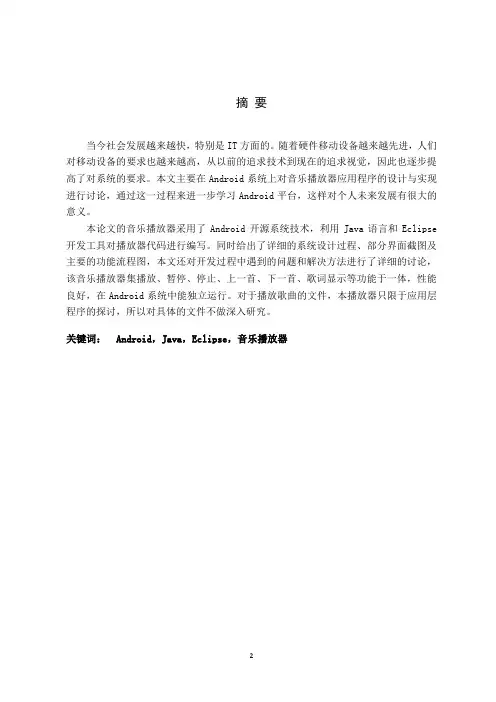
摘要当今社会发展越来越快,特别是IT方面的。
随着硬件移动设备越来越先进,人们对移动设备的要求也越来越高,从以前的追求技术到现在的追求视觉,因此也逐步提高了对系统的要求。
本文主要在Android系统上对音乐播放器应用程序的设计与实现进行讨论,通过这一过程来进一步学习Android平台,这样对个人未来发展有很大的意义。
本论文的音乐播放器采用了Android开源系统技术,利用Java语言和Eclipse 开发工具对播放器代码进行编写。
同时给出了详细的系统设计过程、部分界面截图及主要的功能流程图,本文还对开发过程中遇到的问题和解决方法进行了详细的讨论,该音乐播放器集播放、暂停、停止、上一首、下一首、歌词显示等功能于一体,性能良好,在Android系统中能独立运行。
对于播放歌曲的文件,本播放器只限于应用层程序的探讨,所以对具体的文件不做深入研究。
关键词: Android,Java,Eclipse,音乐播放器目录摘要 (2)第一章前言 (4)第二章系统需求分析 (5)2.1功能需求 (5)2.1.1 播放器的基本控制需求 (5)2.1.2 播放器的设置模块 (5)2.1.3 文件浏览器 (6)2.2功能需求分析 (7)2.3系统流程 (7)2.4 系统界面需求 (8)2.5系统性能需求 (9)2.6 运行环境需求 (9)第三章Android项目介绍 (10)3.1什么是Android? (10)3.1.1Android的介绍 (10)3.1.2 Android的特性 (10)3.1.3Android 基本框架 (11)3.2Android应用软件开发的核心技术 (11)3.2.1Android应用开发语言 (11)3.2.2 Android应用程序组件 (11)3.3Android开发环境的搭配 (12)3.4 Android模拟器中sd卡的创建和文件的上传 (14)3.4.1SD卡的创建 (15)第四章音乐播放器的详细设计 (16)4.1音乐播放器主界面功能实现 (16)4.2 播放列表功能 (17)4.3 菜单功能 (19)4.3.1菜单界面 (19)4.3.2菜单功能实现 (20)4.4播放设置界面 (21)4.4.1界面实现 (21)4.4.2歌词显示实现 (22)4.5手机扩展卡的访问 (24)4.5.1文件浏览器界面 (24)4.5.2 文件浏览器功能实现 (25)4.6数据存储方式 (26)第五章结论 (27)致谢 (28)参考文献 (29)第一章前言现在人们对手机的要求也越来越高,由于手机市场发展迅速,使得手机操作系统也出现了不同的类型,现在市场上主要有3种手机操作系统,即Windows Mobile、Symbian以及谷歌的android操作系统,其中占有开源代码优势的Android系统有最大的发展前景。
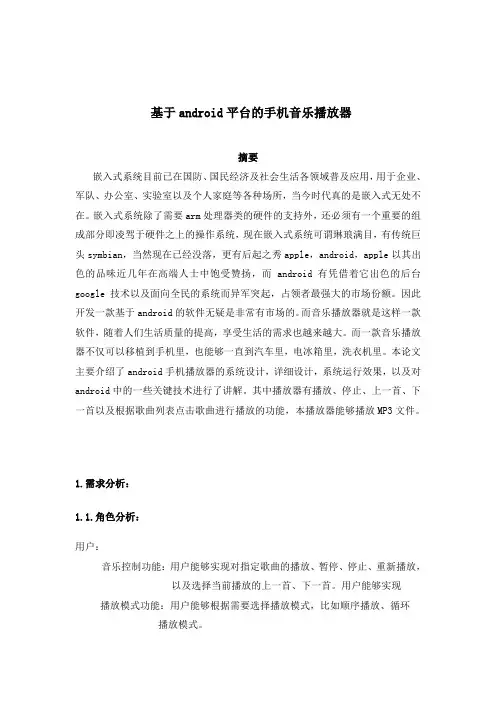
基于android平台的手机音乐播放器摘要嵌入式系统目前已在国防、国民经济及社会生活各领域普及应用,用于企业、军队、办公室、实验室以及个人家庭等各种场所,当今时代真的是嵌入式无处不在。
嵌入式系统除了需要arm处理器类的硬件的支持外,还必须有一个重要的组成部分即凌驾于硬件之上的操作系统,现在嵌入式系统可谓琳琅满目,有传统巨头symbian,当然现在已经没落,更有后起之秀apple,android,apple以其出色的品味近几年在高端人士中饱受赞扬,而android有凭借着它出色的后台google技术以及面向全民的系统而异军突起,占领者最强大的市场份额。
因此开发一款基于android的软件无疑是非常有市场的。
而音乐播放器就是这样一款软件,随着人们生活质量的提高,享受生活的需求也越来越大。
而一款音乐播放器不仅可以移植到手机里,也能够一直到汽车里,电冰箱里,洗衣机里。
本论文主要介绍了android手机播放器的系统设计,详细设计,系统运行效果,以及对android中的一些关键技术进行了讲解。
其中播放器有播放、停止、上一首、下一首以及根据歌曲列表点击歌曲进行播放的功能,本播放器能够播放MP3文件。
1.需求分析:1.1.角色分析:用户:音乐控制功能:用户能够实现对指定歌曲的播放、暂停、停止、重新播放,以及选择当前播放的上一首、下一首。
用户能够实现播放模式功能:用户能够根据需要选择播放模式,比如顺序播放、循环播放模式。
歌曲管理功能:用户能够根据需要添加指定文件夹里的歌曲文件,能够删除歌曲播放列表里指定的歌曲,能够根据条件查找指定的歌曲、显示播放列表歌词管理功能:1)用户能够实现手动添加指定格式的歌词文件,并将它与相应的歌曲进行关联,或者取消关联2)用户能够实现歌曲在网上自动搜索歌词,并将其下载到本地手机里用户指定的文件夹的功能。
前后台功能:用户能够在多个应用程序间进行切换的时候应该能够保证歌曲的正常播放。
1.2.用例分析:1、播放歌曲、暂停歌曲、停止歌曲、重新播放歌曲、上一首、下一首2、选择单曲播放模式、顺序播放模式、循环播放模式3、手动添加歌词、网络自动获取歌词、播放歌曲是同步歌词4、添加歌曲、查找歌曲、删除歌曲5、显示播放列表、后台播放1.3.用例文本:播放歌曲用例文本用例名称:播放歌曲参与者:用户前置条件:程序运行在有播放功能的界面后置条件:播放器开始播放歌曲主成功场景:1.用户点击播放按钮2.播放器播放用户选中的歌曲暂停歌曲用例文本用例名称:暂停歌曲参与者:用户前置条件:有歌曲正在播放且当前页面存在暂停功能按钮后置条件:用户暂停正在播放的歌曲主成功场景:1.用户点击暂停按钮2.播放器暂停正在播放的歌曲停止歌曲用例文本用例名称:停止歌曲参与者:用户前置条件:有歌曲正在播放且当前页面存在停止功能按钮后置条件:用户停止正在播放的歌曲主成功场景:1.用户点击停止按钮2.播放器停止正在播放的歌曲重播歌曲用例文本用例名称:重播歌曲参与者:用户前置条件:当前页面存在重播功能按钮后置条件:用户重播当前正在播放的歌曲主成功场景:1.用户点击重播按钮2.播放器重播正在播放的歌曲重播歌曲用例文本用例名称:设定循环播放模式参与者:用户前置条件:当前页面存在循环播放功能设置按钮后置条件:用户循环播放指定的歌曲主成功场景:1.用户点击循环播放按钮2.设定之后播放器开始循环播放歌曲表2.6添加歌词用例文本用例名称:添加歌词参与者:用户前置条件:当前页面存在添加歌词功能按钮后置条件:歌词与相应歌曲产生了依赖关系主成功场景:1.用户点击添加歌词按钮2.播放器得到歌词并将其存储在适当的位置3.以后播放添加歌词的那首歌时,同步显示歌词添加歌曲用例文本用例名称:添加歌曲参与者:用户前置条件:当前页面存在添加歌曲功能按钮后置条件:歌曲列表有更新主成功场景:1.用户点击添加歌曲按钮2.播放器引导用户到指定的文件夹3.用户选择文件夹里的相应歌曲4.用户点击确认按钮查找歌曲用例文本用例名称:查找歌曲参与者:用户前置条件:当前页面存在查找歌曲功能按钮后置条件:播放器页面显示用户查找到得歌曲主成功场景:1.用户点击查找歌曲按钮2.播放器提示用户根据类别选择要查找的歌曲3.播放器显示指定歌曲删除歌曲用例文本用例名称:删除歌曲参与者:用户前置条件:当前页面存在删除歌曲功能按钮后置条件:指定歌曲被删除了,播放列表有更新主成功场景:1.用户点击删除歌曲按钮2.播放器删除用户所选歌曲显示播放列表用例文本用例名称:显示播放列表参与者:用户前置条件:当前页面存在显示播放列表功能按钮后置条件:当前页面显示播放列表主成功场景:1.用户点击显示播放列表功能按钮2.播放器显示系统存在的所有指定格式的歌曲1.4.用例图:用户(f rom Actors)退出系统(from Use Cases)歌曲管理用例的构成:(from Use Cases)添加歌曲(from Use Cases)歌词管理用例的构成(f 删除歌词(from Use Cases)播放模式控制用例的组成:(f随机播放(from Use Cases)2.系统顺序图播放模块系统顺序图3.模式控制系统顺序图4.系统设计:基于android平台的手机音乐播放器5.实验总结:重最初对android一无所知,到验收的时候做出了一个自己还算满意的播放器我觉得收获还是比较大的,使我对android开发,入了门,理解了其中的重要的基本概念,比如activity,service,intent等。

基于Android的音乐播放器的系统设计的研究报告本文基于Android平台开发了一款音乐播放器,主要实现了歌曲的播放、暂停、切换、调节音量等基本功能。
本文主要介绍了音乐播放器的系统设计,包括面向对象设计、软件体系结构设计及界面设计等。
一、面向对象设计面向对象设计是一种软件设计方法,通过将对象的属性和行为打包在一起,以便更好地管理和重复使用。
本系统的面向对象设计主要包括三个核心类: MediaPlayManager(媒体播放管理器)、 Music(音乐)和 PlayControl(播放控制器)。
MediaPlayManager类是整个系统的核心。
它负责管理音频播放相关的所有操作,如音频资源的获取、播放控制、进度更新、音量调节等。
同时,它还可以屏蔽底层的细节实现,以便更好地隔离系统的其他组成部分。
Music类是储存音频信息的基本单元,存储了音频文件的基本信息,如文件路径、歌曲名、歌手、专辑等信息。
Music类是可重用的,可以被图形用户界面和系统其他组件调用。
PlayControl类是包含系统中所有的用户交互控件,通过监听用户输入来触发音频播放的开始、暂停、停止、快进、快退等操作。
PlayControl类还包含了音量控制和进度条控制,以便更好地处理用户对音频的操作。
二、软件体系结构设计在软件体系结构设计方面,本系统采用面向服务的体系结构设计方法。
本系统包含了多个服务,分别负责从不同的数据源获取数据、音频处理、媒体播放、UI交互等工作。
这些服务各自独立地工作,通过接口来协调彼此之间的工作,以便实现整个系统的功能。
其中最重要的服务是MediaPlayService媒体播放服务,负责整个系统的媒体播放工作,包括MP3音频格式、网络音频、在线音频等媒体类型的播放工作。
另外,本系统还采用了MVVM架构模式,将业务逻辑和视图分开,使得业务逻辑可以单独测试,且可以更加方便的修改和升级。
MVVM模式可以有效地解耦,在注重变化和可维护性方面得到迅速的发展。
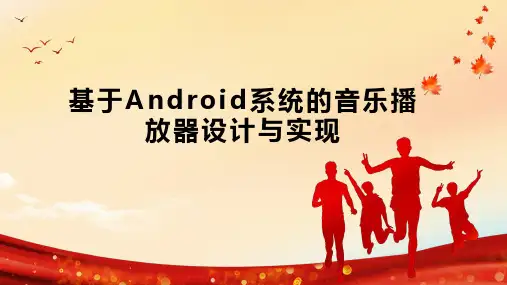
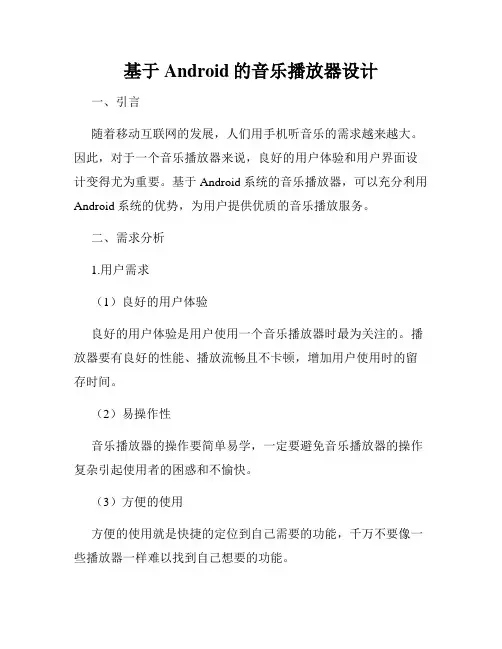
基于Android的音乐播放器设计一、引言随着移动互联网的发展,人们用手机听音乐的需求越来越大。
因此,对于一个音乐播放器来说,良好的用户体验和用户界面设计变得尤为重要。
基于Android系统的音乐播放器,可以充分利用Android系统的优势,为用户提供优质的音乐播放服务。
二、需求分析1.用户需求(1)良好的用户体验良好的用户体验是用户使用一个音乐播放器时最为关注的。
播放器要有良好的性能、播放流畅且不卡顿,增加用户使用时的留存时间。
(2)易操作性音乐播放器的操作要简单易学,一定要避免音乐播放器的操作复杂引起使用者的困惑和不愉快。
(3)方便的使用方便的使用就是快捷的定位到自己需要的功能,千万不要像一些播放器一样难以找到自己想要的功能。
(4)多种音乐格式支持目前音乐格式众多,一个好的音乐播放器一定要支持多种音乐格式的播放。
2.功能需求(1)播放功能重要的功能之一,音乐的播放一定要流畅不卡顿。
(2)歌词功能歌曲的歌词随着音乐的播放同步展示,让用户能够更好的理解和享受音乐。
(3)在线音乐功能在线音乐功能为用户提供了更为丰富的音乐选择,也为音乐平台提供更多的商业合作机会。
(4)下载功能这个功能是当网络环境不好时提供稳定的音乐学习环境,用户可以把歌曲下载下来,随时随地可以听取。
三、系统设计Android的音乐播放器设计1.音乐的存储用户存储的音乐和内建音乐的存储架构不同,因为内建的音乐是从系统预装的资源存储到系统内部存储,并被分类为系统音乐媒体数据库。
用户存储是用户自己存储的音乐,可以自定义目录和分类,因此不能直接做到类似内建音乐的音乐媒体库分类管理。
(2)外置存储外置存储就是SD卡,手动插上才能使用。
当我们访问外置存储的音乐时,需要文件读取的权限。
用户存储的音乐和内建存储的音乐在这个方面是一样的。
2.音乐文件和格式Android音乐播放有两种方式(1)内建资源内建资源的音乐文件保存在/res/raw目录下,这个音乐数据与.apk安装包一起发布。
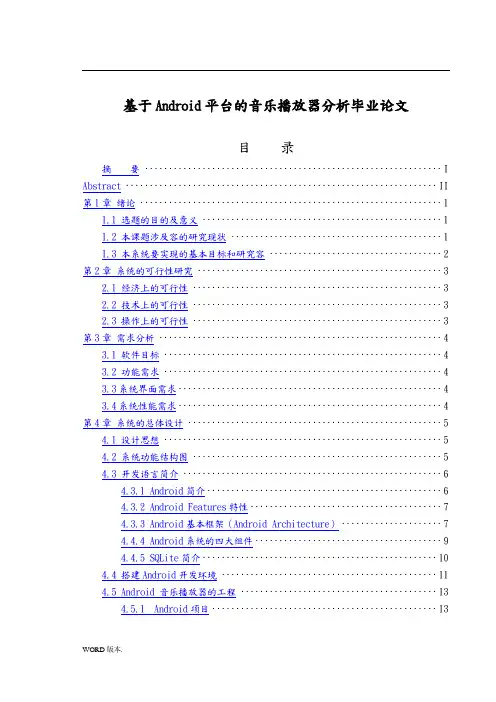
基于Android平台的音乐播放器分析毕业论文目录摘要 (I)Abstract (II)第1章绪论 (1)1.1 选题的目的及意义 (1)1.2 本课题涉及容的研究现状 (1)1.3 本系统要实现的基本目标和研究容 (2)第2章系统的可行性研究 (3)2.1 经济上的可行性 (3)2.2 技术上的可行性 (3)2.3 操作上的可行性 (3)第3章需求分析 (4)3.1 软件目标 (4)3.2 功能需求 (4)3.3系统界面需求 (4)3.4系统性能需求 (4)第4章系统的总体设计 (5)4.1 设计思想 (5)4.2 系统功能结构图 (5)4.3 开发语言简介 (6)4.3.1 Android简介 (6)4.3.2 Android Features特性 (7)4.3.3 Android基本框架(Android Architecture) (7)4.4.4 Android系统的四大组件 (9)4.4.5 SQLite简介 (10)4.4 搭建Android开发环境 (11)4.5 Android 音乐播放器的工程 (13)4.5.1 Android项目 (13)4.5.2 Android工程程序结构 (14)4.5.3 AndroidManifest.xml文件 (15)第5章数据库的设计 (18)5.1 数据库表的介绍 (18)5.1.1用户注册表 (18)5.1.2 完成下载的音乐表 (19)5.1.3 播放清单表 (19)5.2 数据库连接 (19)第6章系统详细设计 (21)6.1 欢迎界面模块详细设计 (21)6.2播放列表模块详细设计 (22)6.3 歌曲播放模块详细设计 (25)6.4 本地音乐模块详细设计 (27)6.5 会员登录模块详细设计 (29)6.6 会员注册模块详细设计 (32)6.7 音乐下载模块详细设计 (34)6.8 设置皮肤模块详细设计 (36)第7章系统测试 (38)7.1 登录功能测试 (38)7.2 图片上传功能测试 (39)7.3 文件上传功能测试 (39)结论 (40)参考文献 (41)致谢 (42)第1章绪论1.1 选题的目的及意义Android是谷歌于2007年公布的开放式源代码手机系统,它的开放性就优于其它封闭式的手机系统,因此,任何人都可能根据自己的喜好将手机系统中的所有功能重新编写。
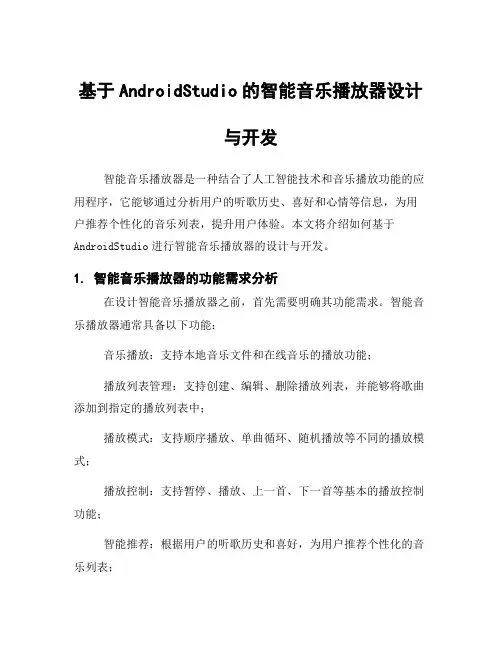
基于AndroidStudio的智能音乐播放器设计与开发智能音乐播放器是一种结合了人工智能技术和音乐播放功能的应用程序,它能够通过分析用户的听歌历史、喜好和心情等信息,为用户推荐个性化的音乐列表,提升用户体验。
本文将介绍如何基于AndroidStudio进行智能音乐播放器的设计与开发。
1. 智能音乐播放器的功能需求分析在设计智能音乐播放器之前,首先需要明确其功能需求。
智能音乐播放器通常具备以下功能:音乐播放:支持本地音乐文件和在线音乐的播放功能;播放列表管理:支持创建、编辑、删除播放列表,并能够将歌曲添加到指定的播放列表中;播放模式:支持顺序播放、单曲循环、随机播放等不同的播放模式;播放控制:支持暂停、播放、上一首、下一首等基本的播放控制功能;智能推荐:根据用户的听歌历史和喜好,为用户推荐个性化的音乐列表;歌词显示:支持显示歌曲的歌词,并实现歌词与音乐的同步显示功能。
2. AndroidStudio环境搭建在进行智能音乐播放器的设计与开发之前,需要搭建好AndroidStudio的开发环境。
首先下载并安装AndroidStudio,然后配置好相应的SDK和虚拟设备,确保可以顺利进行Android应用程序的开发。
3. 项目结构设计在AndroidStudio中创建一个新的项目,定义好项目的结构。
通常一个智能音乐播放器项目包含以下几个主要模块:播放器界面模块:负责展示音乐播放器的界面,包括歌曲封面、歌曲信息、进度条等控件;播放控制模块:负责实现音乐的播放、暂停、上一首、下一首等操作;播放列表管理模块:负责管理用户创建的不同播放列表,并实现歌曲的添加、删除等操作;智能推荐模块:负责分析用户听歌历史和喜好,为用户推荐个性化的音乐列表;歌词显示模块:负责解析歌曲的歌词文件,并实现歌词与音乐的同步显示功能。
4. 功能模块实现4.1 播放器界面设计设计一个美观直观的音乐播放器界面是吸引用户使用的关键。
可以在界面上添加歌曲封面展示区域、歌曲信息显示区域、进度条控制区域等元素,提升用户体验。
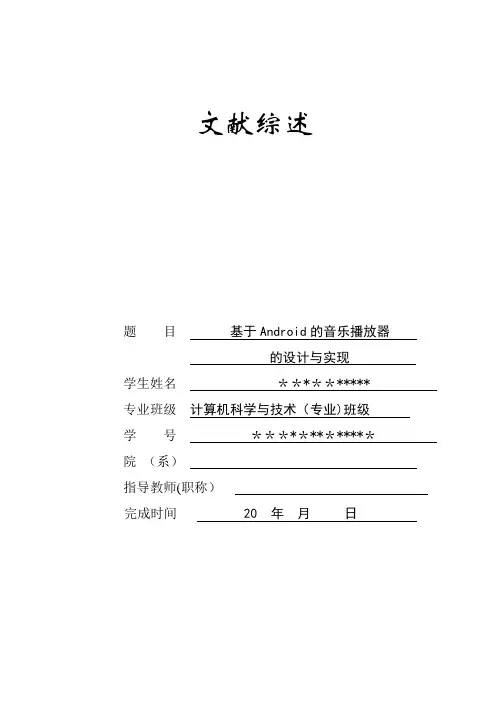
文献综述题目基于Android的音乐播放器的设计与实现学生姓名**********专业班级计算机科学与技术(专业)班级学号*************院(系)指导教师(职称)完成时间20 年月日综述题目:基于Android的音乐播放器的设计与实现综述专业班级:姓名:学号:基于Android的音乐播放器的设计与实现综述摘要随着智能手机的兴起,Android逐渐成为了市场占有量最大的移动平台操作系统,越来越受到大众的欢迎,所以在此平台上开发方便用户使用的音乐播放器则使智能手机变得更加适应生活。
基于Android的音乐播放器的设计针对智能手机用户日常使用的实际情况,对音乐播放器的基本功能需求进行调查分析,确定了音乐播放器所包含的功能和框架。
系统采用软件工程中结构化思想和标准的软件设计流程,基于Android开发平台,实现了读取本地音乐、播放控制功能、音乐分组、后台播放、歌词显示、专辑图片显示、通知栏播放控制等功能模块,使Android手机拥有个性的多媒体音乐播放器,播放音乐更方便快捷,让手机的主人随时随地处于音乐的旋律之中。
Android平台基于Linux 内核,在此平台上,使用Java语言和Eclipse开发工具进行开发音乐播放器系统,使用Android自带数据库SQLite进行数据存储。
关键字音乐播放器;Android;Linux;Java;SQLite综述题目:基于Android的音乐播放器的设计与实现专业班级:姓名:学号:1 引言随着手机的普及以及手机应用的深入人心,近几年“智能手机”成为了人们关注的话题。
在现今这个智能手机系统群雄纷争的时候,2008年Google推出了一款名为Android的开源智能手机操作系统[1]。
Android凭借其开放性和良好的人机界面,受到广大手机生产商的重视。
当今社会,人们的生活节奏越来越快,于是人们对于生活品质的追求越来越高,对于一些电子产品的要求也在提高,以至于当今社会的电子产品更新速度也在不停的加快.随着这些移动设备[2]的功能越来越完善,移动设备的系统平台也日渐火热起来。
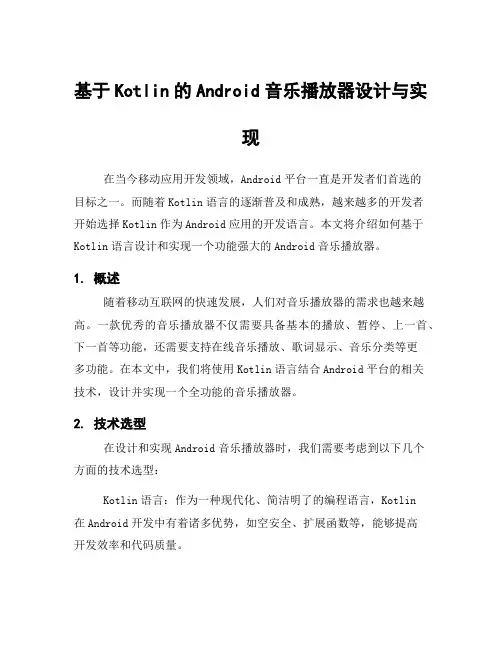
基于Kotlin的Android音乐播放器设计与实现在当今移动应用开发领域,Android平台一直是开发者们首选的目标之一。
而随着Kotlin语言的逐渐普及和成熟,越来越多的开发者开始选择Kotlin作为Android应用的开发语言。
本文将介绍如何基于Kotlin语言设计和实现一个功能强大的Android音乐播放器。
1. 概述随着移动互联网的快速发展,人们对音乐播放器的需求也越来越高。
一款优秀的音乐播放器不仅需要具备基本的播放、暂停、上一首、下一首等功能,还需要支持在线音乐播放、歌词显示、音乐分类等更多功能。
在本文中,我们将使用Kotlin语言结合Android平台的相关技术,设计并实现一个全功能的音乐播放器。
2. 技术选型在设计和实现Android音乐播放器时,我们需要考虑到以下几个方面的技术选型:Kotlin语言:作为一种现代化、简洁明了的编程语言,Kotlin在Android开发中有着诸多优势,如空安全、扩展函数等,能够提高开发效率和代码质量。
MVVM架构:采用MVVM架构能够有效分离视图和业务逻辑,使得代码更易于维护和扩展。
Jetpack组件:Android Jetpack是Google推出的一套组件库,包含了许多常用且高质量的组件,如LiveData、ViewModel等,能够帮助我们快速构建稳定且高效的应用。
ExoPlayer:作为Google推荐的开源播放器框架,ExoPlayer具有强大的定制能力和良好的性能表现,适合用于开发音乐播放器。
3. 功能设计在设计功能时,我们将实现以下主要功能:本地音乐播放:支持扫描本地存储中的音乐文件,并进行播放。
在线音乐播放:支持在线搜索和播放音乐。
歌词显示:显示当前播放歌曲的歌词,并支持歌词同步滚动。
音乐分类:按照歌手、专辑、风格等分类展示音乐列表。
播放列表管理:支持创建、编辑、删除播放列表,并可以将歌曲添加到指定列表中。
4. 实现步骤4.1 创建项目首先,在Android Studio中创建一个新的Kotlin项目,并配置好相关依赖项。
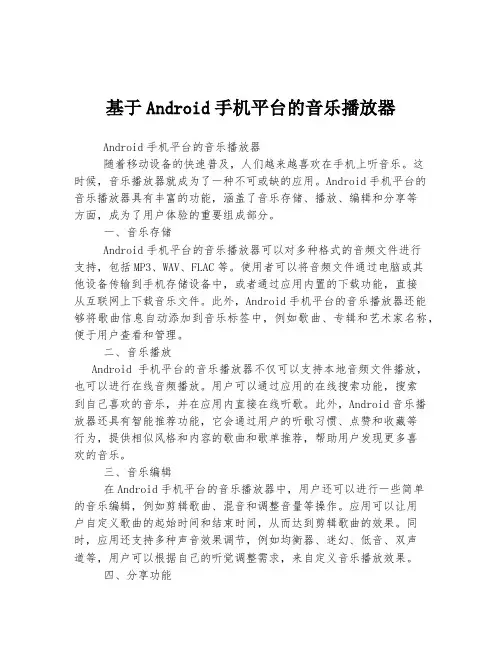
基于Android手机平台的音乐播放器Android手机平台的音乐播放器随着移动设备的快速普及,人们越来越喜欢在手机上听音乐。
这时候,音乐播放器就成为了一种不可或缺的应用。
Android手机平台的音乐播放器具有丰富的功能,涵盖了音乐存储、播放、编辑和分享等方面,成为了用户体验的重要组成部分。
一、音乐存储Android手机平台的音乐播放器可以对多种格式的音频文件进行支持,包括MP3、WAV、FLAC等。
使用者可以将音频文件通过电脑或其他设备传输到手机存储设备中,或者通过应用内置的下载功能,直接从互联网上下载音乐文件。
此外,Android手机平台的音乐播放器还能够将歌曲信息自动添加到音乐标签中,例如歌曲、专辑和艺术家名称,便于用户查看和管理。
二、音乐播放Android手机平台的音乐播放器不仅可以支持本地音频文件播放,也可以进行在线音频播放。
用户可以通过应用的在线搜索功能,搜索到自己喜欢的音乐,并在应用内直接在线听歌。
此外,Android音乐播放器还具有智能推荐功能,它会通过用户的听歌习惯、点赞和收藏等行为,提供相似风格和内容的歌曲和歌单推荐,帮助用户发现更多喜欢的音乐。
三、音乐编辑在Android手机平台的音乐播放器中,用户还可以进行一些简单的音乐编辑,例如剪辑歌曲、混音和调整音量等操作。
应用可以让用户自定义歌曲的起始时间和结束时间,从而达到剪辑歌曲的效果。
同时,应用还支持多种声音效果调节,例如均衡器、迷幻、低音、双声道等,用户可以根据自己的听觉调整需求,来自定义音乐播放效果。
四、分享功能Android手机平台的音乐播放器可以让用户将自己喜欢的音乐分享给他人。
应用内置的分享功能可以让用户将自己的歌单分享到社交网络,例如Facebook和Twitter。
此外,用户也可以将自己喜欢的音乐分享给朋友,通过短信、邮件、即时通讯等方式,与他人分享音乐。
总结Android手机平台的音乐播放器拥有丰富的功能和操作,帮助用户方便的使用手机来听音乐。
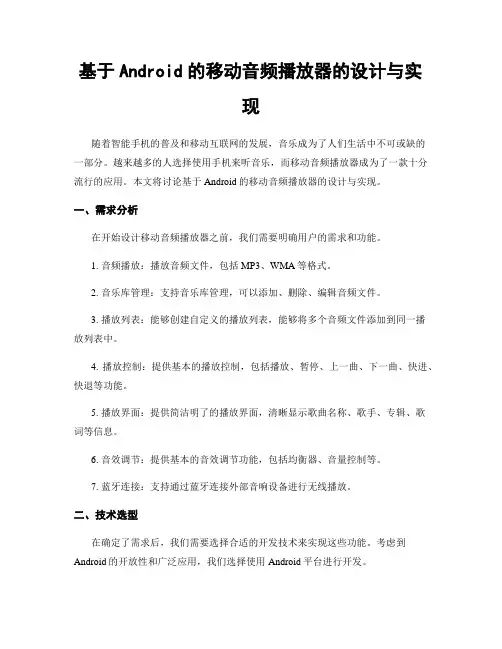
基于Android的移动音频播放器的设计与实现随着智能手机的普及和移动互联网的发展,音乐成为了人们生活中不可或缺的一部分。
越来越多的人选择使用手机来听音乐,而移动音频播放器成为了一款十分流行的应用。
本文将讨论基于Android的移动音频播放器的设计与实现。
一、需求分析在开始设计移动音频播放器之前,我们需要明确用户的需求和功能。
1. 音频播放:播放音频文件,包括MP3、WMA等格式。
2. 音乐库管理:支持音乐库管理,可以添加、删除、编辑音频文件。
3. 播放列表:能够创建自定义的播放列表,能够将多个音频文件添加到同一播放列表中。
4. 播放控制:提供基本的播放控制,包括播放、暂停、上一曲、下一曲、快进、快退等功能。
5. 播放界面:提供简洁明了的播放界面,清晰显示歌曲名称、歌手、专辑、歌词等信息。
6. 音效调节:提供基本的音效调节功能,包括均衡器、音量控制等。
7. 蓝牙连接:支持通过蓝牙连接外部音响设备进行无线播放。
二、技术选型在确定了需求后,我们需要选择合适的开发技术来实现这些功能。
考虑到Android的开放性和广泛应用,我们选择使用Android平台进行开发。
Android平台的开发语言为Java,使用Android SDK和Android Studio进行开发,开发过程中需要了解Android和Java的基础知识。
三、开发过程1. 搭建开发环境在开始开发之前,我们需要按照官方指引搭建Android开发环境,包括安装Android Studio、JDK、SDK和虚拟机等。
确保开发环境正常运行后,我们可以选择创建新项目并进行开发。
2. 实现音频播放功能实现音频播放功能是移动音频播放器的核心部分。
在使用Android开发中,我们可以使用MediaPlayer类来实现音频播放功能。
创建MediaPlayer对象并指定要播放的音频文件路径,然后调用start()方法即可开始播放。
其中,pause()方法用于暂停播放,stop()方法用于停止播放。
班级学号河北XXXXXXXXXXX学院毕业论文题目:基于android平台的音乐播放器姓名专业指导教师河北XXXXXX学院XXXX系二0一二年十二月基于android平台的音乐播放器摘要随着中国进入3G时代,整个软件行业也开始从PC时代逐步转移到后PC时代,从互联网时代转移到移动互联网时代.这个时代是一个充满机遇与挑战的时代,三大运营商进入了新一轮的角逐,手机厂商开始了新一轮的战役,在这场战役中以操作系统为主要武器,在这场战役中Android 异军突起,用了不到三年的时间将诺基亚塞班拉下马,成为世界上最炙手可热的手机操作系统.目前Android是最热门的操作系统,凭借Linux 的软件优势其应用的广泛程度已经让其他对手相形见绌。
所以开发基于Android操作平台的应用具有巨大的意义。
本文就在分析讨论Android手机软件开发技术原理的基础上,开发出能为用户提供更好的基于Android平台的音乐播放器软件.关键字:3G;android;智能手机平台:音乐播放器目录第1章绪论 (4)1.1 项目背景 (4)1.2 编写目的及意义 (4)1。
3 本项目实现的基本目标和研究目的 (5)1.4 参考资料 (5)第2章项目需求分析 (5)2.1 系统界面需求 (5)2.2 系统结构图和流程图 (6)2.3 功能需求 (7)2.3。
1 播放器的基本控制需求 (7)2。
3。
2 播放清单列表管理需求 (9)2。
3.3 播放友好性需求 (10)2.3。
4 功能需求分析 (11)2.4 系统性能需求 (11)2.5 运行环境需求 (11)第3章Android数据库设计 (12)3。
1 数据库表的介绍 (12)3.2 数据库的连接 (13)第4章 Android项目介绍 (16)4.1 开发语言简介 (16)4.2 搭建Android开发环境 (19)4.3 Android 音乐播放器的工程 (19)第5章系统功能详细设计 (24)5。
基于Android平台音乐播放器的设计与实现基于Android平台音乐播放器的设计与实现摘要:随着智能手机的普及,人们对于音乐的需求也日益增长。
为了满足用户的需求,开发一款功能齐全、用户友好的音乐播放器势在必行。
本文以Android平台为基础,介绍了一款基于Android系统的音乐播放器的设计与实现过程。
文章包括需求分析、系统架构、界面设计与实现,以及核心功能的实现等方面的内容。
1.引言音乐是人们生活中不可或缺的一部分,它可以带来欢乐、安慰和启迪。
随着智能手机的普及,人们可以在任何时间、任何地点都能够享受音乐的乐趣。
因此,为用户提供一款功能强大、操作简便的音乐播放器就显得尤为重要。
2.需求分析用户对于音乐播放器的需求主要包括以下几个方面:支持多种音频格式的播放、支持在线音乐的播放、允许用户创建和管理歌单、提供良好的用户界面和用户体验、支持音频文件的下载与管理,同时还要保证音乐播放器的稳定性和性能等。
3.系统架构本音乐播放器采用MVC(Model-View-Controller)架构,将系统分为数据模型层、视图展示层和控制器层。
数据模型层主要负责数据的存储和管理;视图展示层负责界面的展示;控制器层负责处理用户输入和产生相应的输出。
4.界面设计与实现为了提供良好的用户体验,本音乐播放器采用了简洁、直观的界面设计。
主界面分为歌曲列表、播放控制、歌曲信息显示以及歌词展示等几个部分。
用户可以通过界面上的按钮实现歌曲的播放、暂停、上一曲、下一曲等操作。
同时,还可以实现歌曲的搜索、下载和管理等功能。
5.核心功能实现5.1 音乐播放通过Android系统提供的MediaPlayer类实现音乐文件的加载、播放、暂停和停止等功能。
同时,为了提高用户体验,还可以实现歌曲进度条的显示和拖动。
5.2 在线音乐播放通过与云音乐平台的接口对接,实现在线音乐的搜索和播放功能。
用户可以通过输入歌曲名称或者歌手名称,快速找到想要播放的歌曲,并进行在线试听。
基于Android系统的音乐播放器的设计与实现摘要:进入21世纪的数字时代,网络发展十分的迅猛,在现今工作压力大的社会下,娱乐随之兴起,各种各样的网络游戏、娱乐软件像雨后春笋一样以不断更新的方式进入我们的生活,丰富了我们的业余时间。
这些游戏能在不同的操作平台上进行安装,且其安装、操作简单适合每一位玩家,让所有的玩家都能畅玩一番。
然而在所有的操作系统中,Android系统无疑不是其首选的。
在Android平台上发布的酷狗、酷我、百度影音等等播放器,以其简单快捷的操作,好看的画面,舒适的结构,强大的功能所折服我们。
本文通过Android技术的研究,实现了自主设计的一款音乐播放器,完成了本地音乐的加载、最近音乐播放的加载、正在播放页面的实现、上一曲、下一曲、暂停、播放、继续播放、进度条、时间显示等等这些功能。
本款音乐播放器采用TabHost进行总框架的布局,其他部分则采用相应的布局方式,使这款播放器看上去丰富,形象点。
同时这款播放器操作简单、实用、结合了Android课中所学到的很多知识,即对知识的一个总结。
本音乐播放器的设计遵循企业软件的工程思想,开始模拟了客户来公司洽谈某项业务,完成需求分析、界面设计、编写代码、进一步社交、产品的维护、用户需求。
这一系列的流程来一步步的制作这款播放器。
关键字:Android、播放器、客户、操作、流程Abstract:Digital era in twenty-first Century, network development is very rapid, in today's stressful society, along with the rise of various kinds of entertainment, network game,entertainmentsoftware like bamboo shoots after a spring rain as to continuously update the way into our lives,enrichour spare time. These games can be installed in different operating platform, and its installation, operation is simple and suitable for every game player, let all thegame player can play a.However, all of the operating system, the Android systemis not the preferred. Published in the Android platform on the cool dog, cool, and so on Baidu video player, with itssimple andquick operation, beautiful pictures, comfortablestructure, powerful function by us. In this paper, through the research of Android technology, realizes anindependent design and music player, the local musicloading, recently playing music, playing loading page realization, a song, the nextsong, play, pause, continue to play, a progress bar, time display and so on thesefunctions. The music player using TabHost frame layout,the other part is the corresponding arrangement way,make theplayer look rich, image point. At the same time,the player has the advantages of simpleoperation,practical, combined with a lot of knowledge learned inAndroid class, or a summaryof knowledge. The design of the music player follows the business softwareengineering thought, began to simulate the customers to the company to discuss some business, complete therequirementanalysis, interface design, code, furthersocial, product maintenance, user demand. This a series ofthe process step by step, making the player.Key Words:Android 、Player、Customer、Operation、Process目录第1章绪论 (3)1.1A NDROID简介及其开发背景 (4)1.2本课题内容的概述 (5)1.3本课题的目的及意义 (5)第2章开发工具的简介 (5)2.1什么是E CLIPSE? (5)2.2JDK的下载与安装 (8)2.3E CLIPSE的下载与安装 (11)2.4E CLIPSE中A NDROID SDK插件的下载与安装 (12)第3章 ANDROID的基本结构 (17)3.1A NDROID 的基本框架 (17)3.2A NDROID系统的四大组件 (19)3.3A NDROID音乐播放器的详细设计思想 (20)第4章本系统内容需求 (21)4.1实现的内容需求 (21)4.2播放器实现的目标 (22)4.3播放器的基本控制需求 (22)4.4功能需求分析 (23)第5章 ANDROID的项目介绍 (25)5.1本地音乐列表界面 (25)5.2正在播放界面 (26)5.3退出播放器界面 (29)5.4A NDROID M ANIFEST.XML文件介绍 (30)第6章 ANDROID模拟器读取SD卡中音频文件的实现 (30)6.1怎样在模拟器中添加音频文件并读取 (30)6.2SD卡的创建 (30)6.3向SD卡里面上传文件 (31)6.4手机SD卡音频文件读取的代码 (31)第7章软件测试 (31)7.1软件测试环境 (31)7.2测试阶段 (31)7.3测试要点和总结 (32)7.4测试结果 (32)结束语 (33)参考文献 (34)致谢 (34)第1章绪论1.1 Android简介及其开发背景Android一词的本意是指“机器人”,同时也是Goolge与2007年11月5日宣布的基于Linux平台的开源手机操作系统的名称,该平台由操作系统、中间件、用户界面和应用软件组成。
基于Android的音乐播放器软件的设计与实现一、本文概述随着智能移动设备的普及和互联网技术的发展,音乐已经成为人们日常生活中不可或缺的一部分。
作为一款广泛使用的移动操作系统,Android平台上的音乐播放器软件种类繁多,功能各异。
本文将详细介绍一款基于Android的音乐播放器软件的设计与实现过程,包括需求分析、架构设计、关键功能实现以及用户体验优化等方面。
通过对该音乐播放器软件的深入剖析,旨在为开发者提供一个全面、系统的移动音乐播放器开发参考,并探讨音乐播放器软件在Android平台上的发展趋势和未来挑战。
在本文中,我们将首先进行需求分析,明确音乐播放器软件的核心功能和用户期望。
接着,我们将介绍整体架构设计,包括各个模块的功能划分和相互之间的交互方式。
在关键功能实现部分,我们将详细阐述音频解码、播放控制、用户界面设计以及网络音乐服务等核心功能的实现原理和技术细节。
我们还将关注用户体验优化,探讨如何通过界面设计、交互逻辑以及性能优化等手段提升用户满意度。
我们将对本文进行总结,回顾音乐播放器软件的设计与实现过程,并展望未来的发展方向。
我们相信,随着移动技术和音乐产业的不断发展,Android平台上的音乐播放器软件将不断创新和完善,为用户带来更加丰富的音乐体验。
二、Android平台概述Android是由Google和开放手机联盟共同开发的基于Linux内核的开源操作系统,专为移动设备设计。
自2008年发布以来,Android 已经成为全球最流行的移动操作系统之一,覆盖众多手机、平板电脑以及其他类型的设备。
Android的开放性和灵活性使得开发者能够轻松访问底层硬件功能,并为用户创造丰富的应用体验。
Android系统架构采用分层设计,主要包括应用程序层、应用框架层、系统运行库层和Linux内核层。
应用程序层包含了所有安装在Android设备上的应用程序,如音乐播放器、游戏等。
应用框架层为开发者提供了丰富的API,使得他们能够利用系统核心功能开发新的应用程序。
3rd International Conference on Management, Education, Information and Control (MEICI 2015)Design and implementation of the music player based on AndroidJunli XuCollege of Information Engineering, Jiangxi University of Technology, Jiangxi Nanchang Keywords: Android; Music player; Java; EclipseAbstract. in order to solve the problem of complex functions and large required memory of mobile phone music player on the current market, a new music player of simple, convenient, less required memory as well as user-friendly is developed. Based on the Android technology, using the Java language and Eclipse programming tools lead to design and coding of music player. The new design mainly realizes six core functions including main play interface, playlists, menus, play settings, file browsing and song search. This player has merits of high performance, simple operation, and run independently on the Android mobile devices. At the same time, the player can also browse and access files in mobile phones.IntroductionAndroid is open source code mobile phone operating system that comes out by Google in November 2007. Its appearance has broken the traditional closed mobile phone operating system. Anyone can modify the mobile phone operating system as well as function according to personal preference, which is also the most attractive merit of Android. Music player in this article is application software based on Google Android.Android’s application on mobile terminals also completely broke the traditional understanding of the mobile terminals. And appreciate music is one of the best ways to relieve pressure in stressful modern society life. Therefore, many kinds of mobile phone players are also developed. However, a lot of players devote to fancy appearance and function, while caused resources wasting to the user's mobile phone, such as large required memory and CPU, which brings a lot of inconvenience as multiple programs running at the same time. For the most ordinary users, many functions are useless. The purpose of this article is to develop a player which can play the mainstream music file format. To browse and query the storage space as well as operation of adding, deleting, and playing can be realized. Meanwhile, this software can play, pause and select songs with latest Btn and next Btn according to users’ requirement as well as set up songs’ order and etc,.Music player based on Android application is popular in the market at the present. The completing development of Android operating system gives developers a nice platform, which can learn the popular computer technology combining with learned knowledge, and master the latest knowledge, enrich oneself, and enjoy entertainment.Introduction of developing environment of AndroidThis chapter is mainly to study and introduce the needed platform for Android music player, and introduction of the needed configuration environment.Build developing environment of Android. The applications of Android need to run based on Android environment. The following is the configuration requirement and installation steps of Android development environment.The required software of the developing environmentOperation system: Windows XP、Linux、Windows 7Software:Android SDK(Software Development Kit)、ADT(Android Development Tool) IDE environment:Eclipse IDE + ADT Eclipse3 or higherJDK:Java Runtime Environment virtual machine、Java Development Kit(JDK)Installation steps of the developing environmentStep 1: install the Java virtual machine JDK version - 6Step 2: install Eclipse3-5 tools; download address: http://www-eclipse-org/downloads/ Step 3: install the Android SDK: first download the Android SDKDownload address: http://developer-android-com/sdk/index-htmlStep 4:Install Android ADT plug-in, run Eclipse and select help - > install new software and select add.Input SDK tools path in the SDK location: D: \ android \ software \ android SDK –Windows and click OK. The Android environment is set up successfully.The design principle of android application. Twice the result with half the effort will get if an overall study of the principles done before the design and follow them in the operation. The principle of software design mainly includes the following points:(1) ReliabilityThe reliability of the software design must be determined. The reliability of the software system refers to the ability to avoid fault occurred in the process of system running, as well as the ability to remedy troubles once the fault occurs.(2) ReusabilityLook for commonness of similar codes, and come out new method abstractly and reasonably. Pay attention to the generic design.(3) UnderstandabilityThe understandability of software not only require clear and readable document, but the simplified structure of software itself, which requires the designer possess keen insight and creativity, and know well about the design objects.(4) Simple programTo keep the program simple and clear, good programmers can use simple program to solve complex problems.(5) TestabilityTestability means that the created system has a proper data collection to conduct a comprehensive test of the entire system.(6) The Open-Closed PrincipalModule is extensible but cannot be modified. That is to say, extension is open to the existing code in order to adapt to the new requirements. While modify is closed to the categories. Once the design is completed, the categories cannot be modified.Function and structure design of Android system. This system adopts the modularized program design, and system function is correspondingly divided into function modules, the main modules include:(1)UI function module design of mobile terminal: the index screen, play screen, music adding page, file management page are realized.(2) Backstage function module design of mobile terminal: the specific function, music file data storage function and other function are implemented.Requirement Analysis of SystemThe feasibility analysis. This section verified that it is feasible to add music player on the Android system from the aspects of economic, technical and social feasibility.Economic feasibilityTo design Android mobile phone music player as long as a computer has the Android development and the application development of Android is free. In addition, mobile phone music player is basic needs for public. The information that which functions are necessary form all the consumers , which functions are needed for some people, and which features are seldom to use is easy to understand. And a lot of research is eliminated, thus saved the spending. Therefore, the whole process of development doesn’t need to spend any money that is economic feasibility.Technical feasibilityTo design a music player which meets the basic requirements, a deep understand of JAVA language, the Eclipse development tools, SQLlite databases, the Android system architecture, application of framework and other technical knowledge are needed.(framework is the core of the application, and rules that all the programmers participating in the development must abide by). Based on the related technology information and resources for Android on the market, and equipped with technical personnel of technology and the spirit of willing to learn, the technology is feasible.Social feasibilityWith the rapid development of the mobile phone market, all kinds of audio and video resources are widely circulated on the Internet. These resources seem ordinary, but have gradually become an indispensable part of people life, which derived the development of all kinds of mobile phone player. But a lot of players devoted to fancy appearance, strong function causing a lot of wasted resources to the user's mobile phone and bringing a lot of inconvenience to the user as multitasking operation is needed. Some functions are useless to ordinary people. Powerful player is a good thing, but a lot of functions are actually useless for most users. Aimed at these problems, developing multiplied audio player which owns the features of simplified functions, common play function, meeting the needs of most users, less required memory and high quality of playing music, maximizes the optimization in performance.Saturation Overview. This section describes requirements of the system based on basic control functions of players, list management of the player and system setup function of the player according to research results of the project demand.According to the research results of project demand, the basic requirements of project system and its function structure are presented. And describe the demand of the system through the different angles. The project is divided into the following parts by using diagram: the basic control functions of the player, the playlist management function of the player and system setting function of the player. The player interface requires rational layout, comfortable color, friendly control buttons and concise and beautiful images. According to the Android system requires, the non- response time is 5 seconds. The following is requirements in the music player development application.Application response time shall not exceed 5 seconds in music playing.Application response time shall not exceed 5 seconds as the music is suspended.Application response time shall not exceed 5 seconds as the music is stopped.Application response time shall not exceed 5 seconds as Move Next/Move Previous music.Application response time shall not exceed 5 seconds as system listing is required.System designIn this chapter, design steps and the results of functional modules in the system are given in details.Introduction of player project. In this section, the App Starting module of the player in the project is introduced, as well as the Android engineering program structure, etc.Introduction of AppStarting module in the projectAny AppStarting needs AndroidManifest. XML file to start. And any new project content will automatically generate an AndroidManifest. XML file. Configuration files are the core of the whole program, which contains the Android SDK version, and the default Activity in program running. The systems will automatically looking for a logo in AndroidManifest to react the corresponding operation when any component of the program triggers events.To define the system, the first thing is launching the Activity: Android Activity. There are properties such as action and category in < intent - filter >. Most of these are the default values of the system. Setting the action and category realize the switch between different Activities. When any components of the program is about to use, declaration must be in the Android Manifest. Xml files.To be clear that authorities must be illustrated as the statement of provider. Each component has a lot of attributes; the program will define different attributes according to different needs.Introduction of engineering program structureThe basic structure content of Android project includes: the SRC (source code), gen (constant that Android system automatically generates), res (resource file), and the layout of file and pictures in the main storage program interface, which is shown as in fig. 1.Part of the function design. The main play interface designConvenience and practical should be fully considered in the design of the main interface. Every Android interface is a visual interface, which has its unique layout configuration files. We can configure various layout and resources files according to the requirements, such as images, text and color reference, which can form different visual interface and glaring effect.Interface design of adding songsThere are no corresponding songs for the first time login entering the program; users need to add songs to play. Therefore, you need to enter the adding songs’ interface. The empty playlist needs to add songs which can choose from the SD card to add.Function design of play and Next/Move Previous musicWhen need to use the player to play appropriate music, click the play button to realize the function.When need to use the player to switch to the previous song, click on “Move Previous music” button to realize the function.When need to use the player to play the next song, click on “the next music”button to realize the function.Playlist design. A view called List View in Android, with the characteristic of Base Adapter attribute. This can display the form of top to bottom or left to right. The default form of the system is each line only shows a Text View, while this playlist realized the user-defined form. The List View shows one music pictures and one song’s name in every row. We defined a class Music Adapter inherited Base Adapter. And expand the adapter through algorithm, in which a picture and a song’s name can be shown in the first line. Because the Base Adapter is an abstract class, we need to implement the abstract method “get View”, which returns a View. View can be displayed on the Activity, so the playlist interface will come out.The design and realization of play menus. Realization of play menusPlay menus includes six functions, including play, content, add, delete and delete all. The details are as below:single item choice. There is a RadioButton in RadioGroup. Multiple RadioButton items can only select one; play mode of the player includes single cycle, random play, play in order etc. MediaPlayer have a monitor, which insures the songs’playing and complete. When songs played complete, method OnCompletionListener will be triggered. In the method the operation after completion of play will be processed.The lyrics settingThe lyric present is realized by a button called ToggleButton which includes start and off. When it is open, the lyrics will display, on the contrary, it will be closed. ToogleButton also has a listener, which can obtain different states of ToogleButton. Instantiation (ToggleButton) View is used before using. findViewById (R.i d.l y_lrc); and switch on/off state by using ToggleButton. IsChecked.The implementation of lyrics presentThe format of the lyrics in the player is.Lrc files, in which the lyrics format is stored as the format of "time + lyrics". The following will introduce how to read the lyrics in Lrc and stored in the Android files.The storage of XML configuration filesThe content structure of the Android system is as Fig. 2:A content called sdcard is the expansion card with audio files and Lrc lyrics file. If we define a formula of BufferedReader buffer = new BufferedReader (new FileReader (new File ("/sdcard/" + + ". Lrc England "musicName))); specified the path of the Lrc files and read the files into BufferReader. Because two storages need to store time and lyrics respectively, we should define two List < String > container to hold the time and the lyrics. When reading LRC, in each line reading, separate time and lyrics though reoccupy algorithm and add into an array, and store in two lists respectively. Because songs will switch between interfaces in playing, the lyrics must be fixed in a file, rather than as an object, therefore, we will put the two list and lyrics into one configuration file.When writing is finished, android will automatically generate a configuration file in the content data/data/ and /shared_prefs/, which is shown as Fig. 3.The extension card access functions of mobile phones. The application implements the function of the file browser. As a file browser, it must have the function of browsing. When the program is run to browsing interface, all contents of the files and icons will appear. We can see all the files from the file browser, which also can be edited. This program is designed for adding songs of the player, so browsing function is limited to the media file and content browsing containing media files.Data storage. When players run normally, because of the switch among interface, in order to avoid the data lost, we need to store some data for temporary or permanent storage. As a kind of mobile phone operating system, Android provides the following ways for data storage: Preference (configuration), File (documents), SQLite data and network. Application component between each other is independent In Android, and data cannot be shared. In order to realize data sharing, Android provides Content Provider components to realize the sharing of data among applications.ConclusionsThrough the development of music player on Android platform, we get a clear understanding of overall process of the system. The core part of the music player is mainly composed of main interface, playlists, menus, play Settings, file browsing and song search. Grasping the development of the six parts, the music player has had the preliminary scale. Based on the function of the six categories, add some other small features.Music player system realized the basic function of player: play, pause, and stop, up/down a, volume adjustment, lyrics display, play mode, song search, file browser, playlists query, and other functions. This development implicated the popular mobile terminal development technology. This is the combination management of Java language in the open source mobile platform based on Linux system+ + SQLite database support+ SharePreference configuration file. The system realized the music player programming.This design of music player based on Android system requires elaborate design of the music player framework, by adopting Eclipse3.5 + Java language as technical support of this system, with the Android plug-in tools, and combination of Android SDK2.1 version lead to the comprehensive and smoothly design and development of the mobile terminal.AcknowledgementsThis work was financially supported by project of Technology Department of Jiangxi Province [No 20143BBM26048]and the project of Technology Department of Jiangxi Province [No 2013BBE50051] also gives us lots of help.References[1] Xu, J. The Design and Implementation of Music Player Based on Android Platform, Beijing Posts and Telecommunications University, 2011-5:156~178..[2] Wang, Gai. Guide Introduction of Google Android second version,People's Posts and Telecommunications Publishing House 2009-11:263~287[3] Sayed Hashimi, Satya Komatineni, Dave MacLean. Master of the Android 2. People's Posts and Telecommunications Publishing House, 2010-12:154~175.[4] Mark L.Murphy, Li,X. Wu, M interpreted Guide Introduction of Android Development, People's Posts and Telecommunications Publishing House,2010-12:128~156.[5] Reto Meier, Wang, C. interpreted Advanced Programming (2nd edition). Tsinghua University Press, 2010-12: 241~278.[6] Ke, Y. The Android Kernel Profiling. Electronic Industry Press, 2011-9: 231~248.[7] Guo, H. The Android Application Development, Electronic Industry Press. 2010-6: 271~279.[8] Fan Kaiyuan.《J2EE-based Enterprise MIS Design and Implementation 》.Energy Procedia.2011, V ol.11, pp.1972-1977。